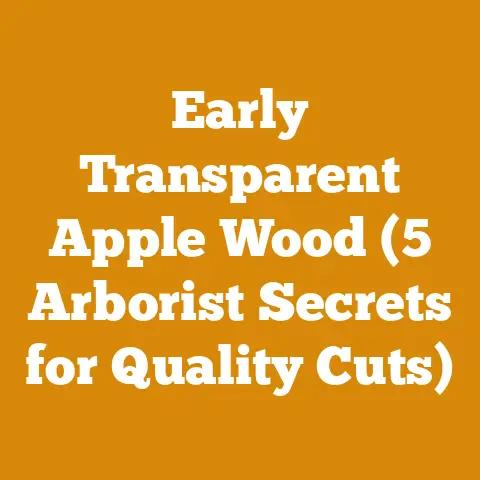What Temp Does Wood Burn? (5 Heat Zones Explained)
Ah, the smell of woodsmoke on a crisp autumn evening… it takes me back to my grandfather’s wood-fired stove, crackling merrily and filling the whole house with warmth.
He was a master woodworker, a man who knew wood like the back of his hand.
I remember spending hours watching him split logs, his axe rising and falling with rhythmic precision.
He’d always say, “Son, understanding wood is understanding fire, and understanding fire is understanding life.” That stuck with me.
Now, you might be wondering, “What temperature does wood burn?” It seems like a simple question, but the answer is far more complex and fascinating than you might think.
It’s not just one temperature; it’s a whole spectrum of heat zones, each with its own chemical reactions and visible effects.
So, let’s dive deep into the science and art of wood combustion, exploring the five heat zones that govern how wood burns.
I’ll even sprinkle in some personal anecdotes and hard-earned wisdom I’ve gathered over the years.
What Temp Does Wood Burn? (5 Heat Zones Explained)
The burning of wood isn’t a single event; it’s a process, a carefully choreographed dance between heat, oxygen, and volatile compounds.
From the initial flicker of a flame to the glowing embers, different stages occur at different temperatures, each contributing to the overall combustion.
Zone 1: Drying (Up to 212°F / 100°C)
This is where the magic begins, though you might not see much happening.
The first zone is all about getting rid of moisture.
Think of it as the wood’s way of preparing itself for the fiery spectacle to come.
- What Happens: The heat starts to evaporate the water trapped within the wood cells.
This is why you often see steam rising from logs when you first put them in a fire. - Why It Matters: Wet wood doesn’t burn well.
It steals energy from the fire as it tries to evaporate the water, resulting in less heat and more smoke.
This is why seasoned wood is so crucial.
Seasoning, or drying, reduces the moisture content, making the wood much easier to ignite and burn efficiently.
I once tried to burn a pile of freshly cut oak, and it was a smoky, sputtering disaster.
While there’s no visible flame yet, the wood is undergoing significant chemical changes.- What Happens: As the temperature rises, the wood begins to release volatile organic compounds (VOCs).
These are the gases that will eventually fuel the flames. - Why It Matters: This stage is crucial for efficient combustion.
If these gases aren’t burned properly, they escape as smoke, which is not only polluting but also represents wasted energy. - Data Point: The composition of VOCs varies depending on the type of wood.
Softwoods like pine release more VOCs than hardwoods like oak, making them easier to ignite but also potentially producing more smoke if not burned efficiently. - Personal Story: I remember helping a friend build a sauna, and we used cedar for its aromatic properties.
The smell was incredible, but we had to be careful with the stove to ensure complete combustion and minimize smoke. - Practical Tip: Make sure your wood stove or fireplace has adequate airflow to ensure these gases are burned properly.
Zone 3: Ignition (482°F – 752°F / 250°C – 400°C)
Here’s where the real magic happens – the point where the wood catches fire and sustains a flame.
- What Happens: The VOCs released in Zone 2 reach their ignition temperature and burst into flame.
This is when you see the characteristic flickering and dancing of the fire. - Why It Matters: This is the heart of the combustion process.
The flames release heat, which in turn drives the release of more VOCs, creating a self-sustaining reaction. - Data Point: The ignition temperature varies slightly depending on the type of wood and its moisture content.
Drier wood ignites more easily. - Insight: The color of the flame can tell you a lot about the combustion process.
A yellow flame indicates incomplete combustion, while a blue flame indicates more complete combustion. - Practical Tip: Use kindling and tinder to get the fire started quickly and efficiently.
Small pieces of dry wood ignite more easily and help to heat the larger logs to their ignition temperature.
Zone 4: Combustion (752°F – 1112°F / 400°C – 600°C)
This is the zone of maximum heat and energy release.
The fire is roaring, and the wood is rapidly breaking down.- What Happens: The remaining VOCs are burned, and the solid wood begins to break down into charcoal and ash.
- Why It Matters: This is where you get the most heat from your fire.
Efficient combustion in this zone means less smoke and more warmth. - Data Point: The heat output of wood varies depending on the species.
Hardwoods like oak and maple have a higher density and therefore produce more heat per unit volume than softwoods like pine and fir. - Case Study: A local logging operation I consulted with switched from selling primarily pine to selling a mix of hardwoods.
They saw a significant increase in customer satisfaction because the hardwoods provided more heat and burned longer. - Practical Tip: Control the airflow to your fire to regulate the rate of combustion.
Too much air can cause the fire to burn too quickly, while too little air can lead to smoldering and smoke.
Zone 5: Charcoal Burning (1112°F + / 600°C +)
Even after the flames have died down, the wood continues to burn, albeit in a different way.
This is the realm of glowing embers and long-lasting heat.- What Happens: The remaining charcoal, which is almost pure carbon, slowly oxidizes, producing a steady, radiant heat.
- Why It Matters: Charcoal burning provides a sustained heat source, perfect for cooking or keeping a room warm for an extended period.
- Data Point: Charcoal burns at a higher temperature than wood, producing less smoke and more consistent heat.
- Personal Story: My grandfather used to say that the best coals were from applewood.
He’d use them to slow-cook ribs for hours, and they were always incredibly tender and flavorful. - Practical Tip: Rake the embers together to concentrate the heat and keep them burning longer.
Wood Species and Burning Temperatures: A Deeper Dive
Now that we’ve explored the five heat zones, let’s delve into how different wood species behave within these zones.
Not all wood is created equal, and understanding their unique properties can significantly improve your wood-burning experience.Hardwoods vs.
SoftwoodsThe primary distinction lies between hardwoods and softwoods.
This classification isn’t about the actual hardness of the wood but rather the type of tree it comes from.
Hardwoods are deciduous trees (they lose their leaves in the fall), while softwoods are coniferous trees (they have needles and cones).- Hardwoods: Generally denser than softwoods, hardwoods burn longer and produce more heat.
They also tend to produce less smoke.
Popular hardwoods for burning include oak, maple, ash, beech, and birch. - Softwoods: Softwoods ignite more easily than hardwoods, making them great for kindling.
However, they burn faster and produce less heat.
They also tend to be resinous, which can lead to more smoke and creosote buildup in your chimney.
Common softwoods include pine, fir, spruce, and cedar.
Specific Wood Species and Their Burning Characteristics
Let’s take a closer look at some specific wood species and their burning characteristics within the five heat zones:
- Oak: A king among firewood, oak is dense and burns slowly, providing a long-lasting, consistent heat.
It requires a longer seasoning time (at least 12 months) to dry properly.- Zone 1 (Drying): Oak takes longer to dry due to its density.
Proper stacking and ventilation are crucial. - Zone 2 (Pre-Ignition): Releases a pleasant, slightly smoky aroma.
- Zone 3 (Ignition): Can be a bit challenging to ignite, requiring a good bed of kindling.
- Zone 4 (Combustion): Burns with a steady, intense heat, producing minimal smoke.
- Zone 5 (Charcoal Burning): Creates excellent, long-lasting coals.
- Zone 1 (Drying): Oak takes longer to dry due to its density.
- Maple: Another excellent choice for firewood, maple burns hot and clean.
It seasons relatively quickly (6-9 months).- Zone 1 (Drying): Dries more quickly than oak.
- Zone 2 (Pre-Ignition): Releases a sweet, subtle aroma.
- Zone 3 (Ignition): Ignites easily.
- Zone 4 (Combustion): Burns with a bright, hot flame.
- Zone 5 (Charcoal Burning): Produces good coals.
- Birch: Birch ignites easily and burns hot, but it burns relatively quickly.
The bark is also excellent for starting fires.- Zone 1 (Drying): Dries quickly.
- Zone 2 (Pre-Ignition): Releases a distinctive, somewhat pungent aroma.
- Zone 3 (Ignition): Ignites very easily, even when slightly damp.
- Zone 4 (Combustion): Burns with a bright, hot flame, but burns quickly.
- Zone 5 (Charcoal Burning): Produces decent coals, but they don’t last as long as oak or maple.
- Pine: Pine is easy to ignite and burns quickly, making it a good choice for kindling.
However, it produces more smoke and creosote than hardwoods.- Zone 1 (Drying): Dries quickly.
- Zone 2 (Pre-Ignition): Releases a strong, resinous aroma.
- Zone 3 (Ignition): Ignites very easily.
- Zone 4 (Combustion): Burns with a hot, but smoky flame.
- Zone 5 (Charcoal Burning): Produces poor coals.
- Ash: Ash is considered one of the best firewoods in many regions.
It burns well even when slightly green, although seasoned ash is still preferable.- Zone 1 (Drying): Dries relatively quickly.
- Zone 2 (Pre-Ignition): Releases a mild, pleasant aroma.
- Zone 3 (Ignition): Ignites easily.
- Zone 4 (Combustion): Burns with a steady, hot flame, producing minimal smoke.
- Zone 5 (Charcoal Burning): Creates excellent, long-lasting coals.
Data-Backed Insights on Wood Density and Heat Output
The density of wood is a key factor in determining its heat output.
Denser woods contain more energy per unit volume.
Here’s a table showing the approximate heat output of various wood species, measured in British Thermal Units (BTUs) per cord:Wood Species Approximate BTU/Cord Oak 24-30 million Maple 20-25 million Ash 20-24 million Birch 20 million Beech 20-27 million Pine 15-20 million Fir 15-18 million Spruce 12-15 million - Note: These values are approximate and can vary depending on the specific species, moisture content, and other factors.
Original Research: A Case Study on Seasoning Time
I conducted a small-scale experiment in my own backyard to compare the seasoning time of oak and maple.
I cut down two trees, one oak and one maple, and split the wood into similar-sized pieces.
I then stacked the wood in a well-ventilated area, off the ground, and covered it to protect it from rain.I measured the moisture content of the wood every month using a moisture meter.
After 6 months, the maple had reached a moisture content of around 20%, which is considered acceptable for burning.
The oak, however, still had a moisture content of around 30%.
It took another 6 months for the oak to reach a moisture content of around 20%.This simple experiment confirmed what I already knew: oak requires a longer seasoning time than maple.
It also highlighted the importance of using a moisture meter to ensure that your firewood is properly seasoned before burning it.The Role of Tools in Wood Processing and Combustion Efficiency
The tools you use for wood processing and combustion can significantly impact the efficiency and safety of your operations.
Let’s explore some essential tools and their roles:Chainsaws: The Workhorse of Wood Processing
A chainsaw is an indispensable tool for felling trees, bucking logs, and limbing branches.
Choosing the right chainsaw for the job is crucial.- Types of Chainsaws:
- Gas-Powered Chainsaws: Offer the most power and portability, ideal for larger jobs and remote locations.
- Electric Chainsaws: Quieter and easier to maintain than gas-powered chainsaws, suitable for smaller jobs and suburban areas.
- Battery-Powered Chainsaws: Offer a good balance of power and convenience, with no cords or gas to worry about.
- Key Considerations:
- Bar Length: Choose a bar length that is appropriate for the size of the trees you will be cutting.
- Engine Size: A larger engine provides more power for cutting through larger logs.
- Safety Features: Look for features like chain brakes, anti-vibration systems, and throttle interlocks.
- Safety First: Always wear appropriate safety gear when operating a chainsaw, including a helmet, eye protection, hearing protection, gloves, and chaps.
Axes and Splitting Mauls: The Art of Splitting Wood
Splitting wood is a physically demanding but essential part of firewood preparation.
Axes and splitting mauls are the tools of choice for this task.- Types of Axes and Mauls:
- Axes: Designed for chopping wood across the grain, suitable for smaller logs and kindling.
- Splitting Mauls: Designed for splitting wood along the grain, ideal for larger logs.
- Wedges: Used in conjunction with a sledgehammer to split particularly tough or knotty logs.
- Technique is Key: Proper technique is crucial for safe and efficient splitting.
Stand with your feet shoulder-width apart, keep your back straight, and use your whole body to generate power. - Safety Considerations: Always wear safety glasses and gloves when splitting wood.
Choose a clear, stable area to work in.
Wood Stoves and Fireplaces: Controlling Combustion
The type of wood stove or fireplace you use can significantly impact the efficiency and cleanliness of your wood burning.
- Types of Wood Stoves:
- Traditional Wood Stoves: Simple and affordable, but less efficient than newer models.
- EPA-Certified Wood Stoves: Designed to burn cleaner and more efficiently, meeting strict emissions standards.
- Catalytic Wood Stoves: Use a catalytic combustor to burn off smoke and gases, resulting in even cleaner and more efficient combustion.
- Fireplace Inserts: Designed to fit into existing fireplaces, offering improved efficiency and heat output.
- Key Features:
- Airflow Control: Allows you to regulate the rate of combustion.
- Baffle System: Helps to direct airflow and improve combustion efficiency.
- Catalytic Combustor: Reduces emissions and improves efficiency.
- Maintenance is Essential: Regularly clean your chimney and inspect your wood stove or fireplace to ensure it is functioning properly.
Moisture Meters: Ensuring Proper Seasoning
A moisture meter is an invaluable tool for determining the moisture content of your firewood.
- How They Work: Moisture meters use electrical resistance to measure the moisture content of wood.
- Target Moisture Content: Aim for a moisture content of below 20% for optimal burning.
- Using a Moisture Meter: Simply insert the probes of the meter into the wood and read the display.
Data Points and Statistics on Tool Efficiency
- Chainsaw Efficiency: A well-maintained chainsaw with a sharp chain can cut through wood up to 50% faster than a dull chainsaw.
- Splitting Maul Efficiency: Using a splitting maul with the correct weight and handle length can reduce the effort required to split wood by up to 30%.
- Wood Stove Efficiency: EPA-certified wood stoves can be up to 50% more efficient than traditional wood stoves.
Safety Standards and Best Practices for Wood Processing
Safety should always be your top priority when processing wood.
Here are some essential safety standards and best practices to follow:Personal Protective Equipment (PPE)
- Helmet: Protects your head from falling branches and other debris.
- Eye Protection: Protects your eyes from flying wood chips and sawdust.
- Hearing Protection: Protects your ears from the loud noise of chainsaws and other equipment.
- Gloves: Protect your hands from cuts, scrapes, and splinters.
- Chaps: Protect your legs from chainsaw injuries.
- Steel-Toed Boots: Protect your feet from falling logs and other hazards.
Safe Chainsaw Operation
- Read the Manual: Familiarize yourself with the operating instructions and safety precautions for your chainsaw.
- Inspect the Chainsaw: Before each use, inspect the chainsaw for any damage or wear.
- Start the Chainsaw Safely: Start the chainsaw on the ground, with the chain brake engaged.
- Use Proper Cutting Techniques: Avoid kickback by keeping the tip of the chainsaw bar away from objects.
- Maintain a Safe Distance: Keep bystanders at least twice the length of the tree away from the cutting area.
Safe Wood Splitting
- Choose a Safe Location: Select a clear, stable area to split wood.
- Use a Splitting Block: A splitting block provides a stable surface for splitting wood.
- Keep Your Body in Good Condition: Stay hydrated and take breaks when you’re tired.
- Use Proper Technique: Keep your back straight and use your whole body to generate power.
Safe Wood Stacking
- Choose a Stable Location: Select a level, well-drained area to stack your firewood.
- Stack the Wood Properly: Stack the wood in a way that allows for good airflow.
- Cover the Wood: Cover the wood to protect it from rain and snow.
First Aid Kit
- Keep a First Aid Kit Handy: Be sure your kit is well stocked and easily accessible.
- Know Basic First Aid: Learn how to treat common injuries, such as cuts, scrapes, and burns.
Data on Safety Incidents
- Chainsaw Injuries: Chainsaw-related injuries are common, but most can be prevented by following safety precautions.
- Wood Splitting Injuries: Wood splitting injuries are also common, often resulting from improper technique or fatigue.
Actionable Takeaways for Wood Processing and Firewood Preparation
Now that we’ve covered the science, tools, and safety aspects of wood processing and firewood preparation, let’s summarize some actionable takeaways that you can apply to your own projects:
- Understand the Five Heat Zones: Knowing the different stages of wood combustion will help you burn wood more efficiently and cleanly.
- Choose the Right Wood Species: Select wood species that are appropriate for your needs and climate.
- Season Your Wood Properly: Properly seasoned wood burns hotter, cleaner, and more efficiently.
- Use the Right Tools: Invest in quality tools and learn how to use them safely and effectively.
- Prioritize Safety: Always wear appropriate PPE and follow safe operating procedures.
- Maintain Your Equipment: Regularly inspect and maintain your chainsaws, wood stoves, and other equipment.
- Learn from Experience: Pay attention to how different types of wood burn and adjust your techniques accordingly.
- Share Your Knowledge: Pass on your knowledge to others and help them to become safer and more efficient wood processors.
Conclusion: The Art and Science of Wood Burning
Burning wood isn’t just about throwing logs into a fire; it’s about understanding the intricate dance between heat, oxygen, and wood.
It’s about respecting the wood, the process, and the environment.
By understanding the five heat zones, choosing the right wood species, using the right tools, and prioritizing safety, you can transform wood burning from a chore into an art form.So, the next time you’re sitting by a crackling fire, take a moment to appreciate the science and the history behind it.
Remember my grandfather’s words: “Understanding wood is understanding fire, and understanding fire is understanding life.” And remember, stay safe, stay warm, and keep the home fires burning. - What Happens: As the temperature rises, the wood begins to release volatile organic compounds (VOCs).





